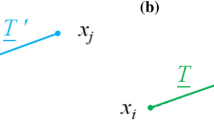Abstract
Most concrete structures are biaxially loaded when cracking occurs and propagates. A test equipment was developed to evaluate fracture mechanic parameters of concrete, based on the principle of wedge splitting. Notched cubic specimens are tested under stable crack propagation. An additional compressive load application device simulates a homogeneous biaxial state of stress. A force-crack opening displacement diagram is obtained from which the specific fracture energy is calculated. The strain softening behaviour is then evaluated by means of numerical modelling. The approach was applied for biaxially loaded concrete samples with 8, 16 and 32 mm maximum size aggregate (MSA). Based on the experimental data a model is developed and discussed. It is found that the fracture energy changes non-uniformly with increasing compressive stress level, and that interaction of microcracking and aggregate interlocking influences the fracture mechanism.
Similar content being viewed by others
References
H. Kupfer, H. K. Hilsdorf and H. Rüsche, J. Amer. Concr. Inst. Aug. 8 (1969) 656.
H. Kupfer and K. H. Gerstle, J. Eng. Mech. Div. ASCE, 99 (1973) 583.
L. J. M. Nelissen, HERON 18 (1972) 1.
I. Rosenthal and J. Glucklich, J. Amer. Concr. Inst. 11 (1970) 903.
K. H. Gerstle et al., Proc. ASCE 106 (1980) 1383.
M. D. Kotsovos and J. B. Newman, J. Amer. Concr. Inst. Sept. 9 (1977) 443.
L. Jiang, J. L. Huang, H. Dahai and X. Nianxiang, J. Amer. Concr. Inst. Mater. March–April 88 (1991) 181.
J. G. M. Van Mier, HERON 31 (1986) 1.
Idem, Materials and Structures. RILEM 19, (1986) 179.
A. J. Zielinski, in “Fracture Toughness and Fracture Energy of Concrete”, edited by F. H. Wittmann (Elsevier, Amsterdam, 1986) pp. 479–489.
J. Weerheijm, H. W. Reinhardt and S. Postma, in “Fracture Processes in Concrete, Rock and Ceramics”, edited by J. G. M. Van Mier, J. G. Rots and A. Bakker (Spon, London, 1991) pp. 839–848.
J. Weerheijm, PhD thesis, Delft University of Technology, 1992.
H. Kreuzer, E. K. Tschegg and W. Wilk, in “Proceedings of the International Conference on Dam Fracture”, edited by V. Souma, R. Dungar and M. Moris, 11–13 September, Boulder, Co 1991 (Electric Power Research Institute, Palo Alto, CA, 1991) pp. 447–457.
E. K. Tschegg, H. Kreuzer and M. Zelezny, in “Proceedings of the First International Conference on Fracture Mechanics of Concrete Structure”, edited by Z. P. Bazant, 1–5 June, Breckenridge, CO, 1992 (Elsevier, London, 1992) pp. 455–460.
M. Elser, MSc thesis 1991, Technical University, Vienna, Austria (in German).
RILEM draft recommendation (50-FMC), Mater. & Struct. 18 (1985) 287.
E. K. Tschegg, Patent AT No. 390328, patent application 31 January 1986 (in German).
Idem, Patent AT No. 396997, patent application, 4 January, 1990 (in German).
Idem, Materialprüfung/Mater. Testing 33 (1991) 338.
E. Brühwiler and F. H. Wittmann, Eng. Frac. Mech. 35 (1990) 117.
Z. Guofan, Jiao Hui and X. Shilang in “Fracture Processes in Concrete, Rock and Ceramics”, edited by J. G. M. Van Mier, J. G. Rots and A. Bakker (Spon, London, 1991) pp. 789–798.
K. Rokugo, M. Iwasa, T. Suzuki and W. Koyanagi in “Fracture Toughness and Fracture Energy”, edited by H. Mihashi H. Takahashi and F. H. Wittmann (Balkema, Rotterdam, 1989) pp. 153–163.
E. K. Tschegg, T. M. Tan and S. E. Stanzl, ASTM Testing & Eval. (submitted).
E. K. Tschegg, M. Elser and S. E. Stanzltschegg, Cement & Concr. Comp. (submitted).
J. G. M. Van Mier, Cement & Concr. Res. 1 (1991) 1.
M. Kotsovos and J. B. Newman, Concr. Res. (London) 33 (1981) 103.
A. Hillerborg, A. Modeer, and P. E. Peterson, Cement & Concr. Res. 16 (1976) 773.
P. E. Roelfstra, PhD thesis, Ecole Polytechnique Federale de Lausanne, Lausanne, 1988.
Idem, Private communication, 1991.
T. C. Hsu, G. M. Sturman and G. Winter, Proc. Amer. Concr. Inst. 60 (1962) 209.
N. Nomura, H. Mihashie and M. Izumi, in “Fracture Processes in Concrete, Rock and Ceramics”, edited by J. G. M. Van Mier, J. G. Rots and A. Bakker (Spon, London, 1991) pp. 51–60.
P. Zdenek and P. Bazant, J. Eng. Mech. 110 (1984) 518.
H. K. Hilsdorf and W. Brameshuber, “Baustoffe” (Bauverlag, Wiesbaden, 1985) pp. 62–72.
Author information
Authors and Affiliations
Rights and permissions
About this article
Cite this article
Tschegg, E.K., Elser, M. & Kreuzer, H. Mode I fracture behaviour of concrete under biaxial loading. JOURNAL OF MATERIALS SCIENCE 30, 235–242 (1995). https://doi.org/10.1007/BF00352155
Received:
Accepted:
Issue Date:
DOI: https://doi.org/10.1007/BF00352155



